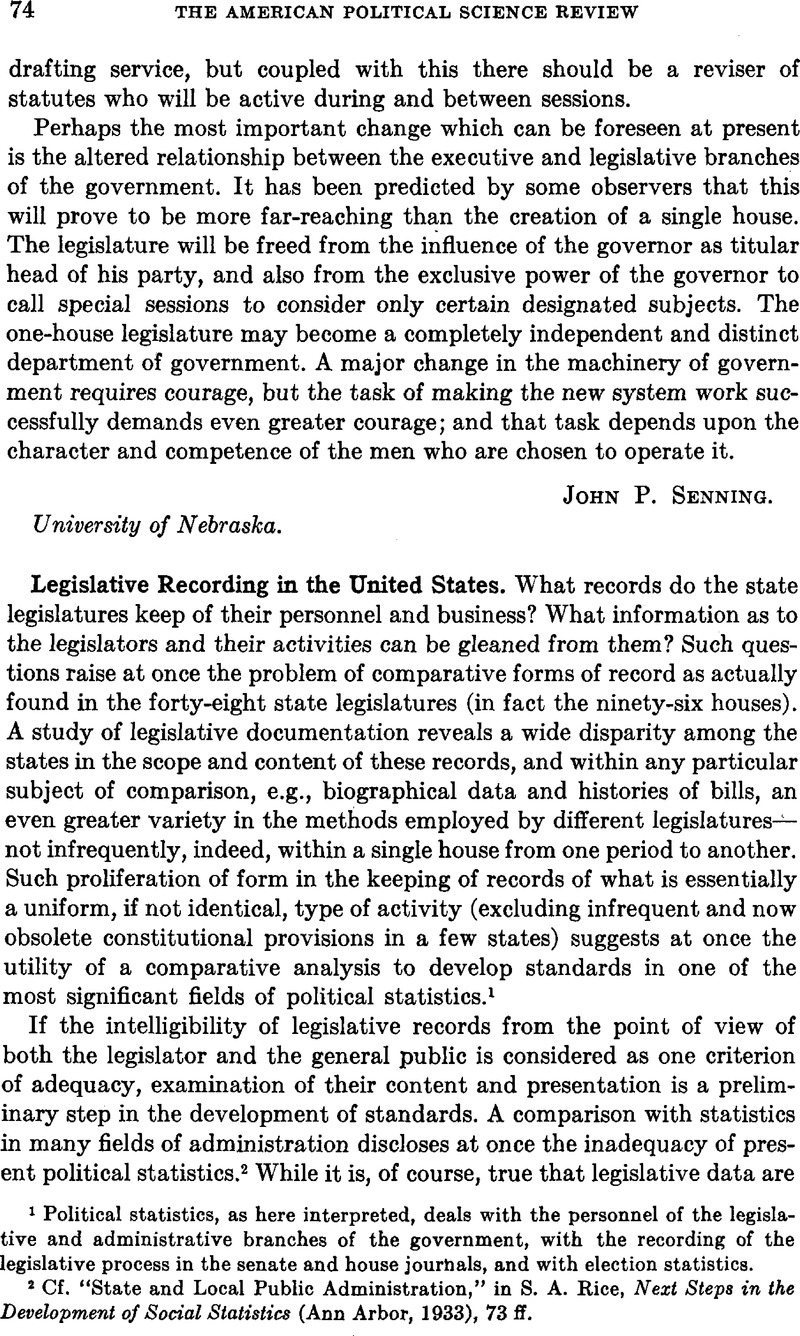No CrossRef data available.
Article contents
Legislative Recording in the United States
Published online by Cambridge University Press: 02 September 2013
Abstract

- Type
- Legislative Notes and Reviews
- Information
- Copyright
- Copyright © American Political Science Association 1935
References
1 Political statistics, as here interpreted, deals with the personnel of the legislative and administrative branches of the government, with the recording of the legislative process in the senate and house journals, and with election statistics.
2 Cf. “State and Local Public Administration,” in Rice, S. A., Next Steps in the Development of Social Statistics (Ann Arbor, 1933), 73 ff.Google Scholar
3 A survey of the records of city councils for some twenty cities of varying populations and in different parts of the country failed to yield a single instance in which these records were not purely formal in character. The number and title of ordinances passed and the record of votes upon them were usually included. Otherwise no important data were obtainable, and not infrequently the votes of members of the council were omitted. There is usually to be found in the annual reports or in separate publications a roster of members of the city administration.
4 Since the completion of this study there has appeared, Robinson's, E. E.The Presidential Vote, 1896–1982 (Stanford University Press, 1934)Google Scholar. The general note on sources, p. 379 ff., is the most complete published record to date of sources for election statistics for the period covered.
5 The largest record disclosed in this survey was that of the Florida legislature of 1931, the journals of both houses of which ran to over 12,000 pages. In that year, the stenographic and clerical costs of the legislature approximated, and, in the case of one house, exceeded, the salaries and other expenses of the legislators.
6 A summary of the data discussed above indicates that only the Kentucky senate and house journals print all bills in full (appropriation bills are printed in the Connecticut senate journals; the Alabama senate and house journals and the Florida senate journals include the texts of all local acts). Amendments to bills are printed in full except in the Oregon, Utah, Washington, West Virginia, and Wyoming senate journals, and the Delaware, Oklahoma (abstracts), Oregon, Washington, West Virginia, and Wyoming house journals.
Daily roll-calls (for quorum purposes at the beginning of each day's sessions) are included in the senate journals of Alabama, Arizona, Arkansas, California, Colorado, Delaware, Florida, Georgia, Idaho, Indiana, Kentucky, Louisiana, Maryland, Massachusetts, Michigan, Minnesota, Mississippi, Missouri, Nebraska, Nevada, New Jersey, North Carolina, Texas, Utah, Vermont, West Virginia, Wisconsin, Wyoming; and the house journals of Alabama, Arizona, Arkansas, California, Colorado, Delaware, Florida, Georgia, Idaho, Indiana, Kentucky, Louisiana, Maine, Maryland, Massachusetts, Michigan, Minnesota, Mississippi, Missouri, Nebraska, Nevada, New Jersey, New York, North Dakota, Oklahoma, South Dakota, Texas, Utah, Vermont, West Virginia, Wisconsin, and Wyoming. Absentees only are listed in the North Dakota and Oregon senate and the Oregon house journals.
Roll-calls on third reading are included except in the Senate journals of Connecticut (on demand), Maine, New Hampshire, Oklahoma, Oregon, South Carolina (on demand); and in the house journals of Connecticut (on demand), Maine, Oregon, and South Carolina (on demand).
Committee reports are printed in full in the senate journals of Arizona, California, Florida, Minnesota, New York, North Dakota, and Texas; in the house journals of Arizona, California, New Hampshire, New York, Oklahoma, Texas, West Virginia, and Wyoming, and abstracts in Idaho and Illinois.
Joint conference committee reports are printed in full in the senate journals of Arizona, California, Florida, Georgia, New York, North Dakota, and Texas; in the house journals of Arizona, California, New Hampshire, Oklahoma, Texas, West Virginia, and Wyoming. Elsewhere, general and joint conference committee reports are printed by number and title only.
Governors' messages, whether annual, special, or veto, are very generally printed in the journals of both houses. In a few states, one or more types are omitted. In only ten senate journals and nine house journals is any one of the types not included.
7 The manuals of Minnesota and Wisconsin, for example, give the vote for some elective officers in every voting precinct or election district in the state.
8 Cf. Swisher, I. G., “Election Statistics in the United States,” in this Review, Vol. 27, p. 422Google Scholar, for a complete review of contemporary sources for election statistics. The tables below indicate the biographical and election statistics available in existing legislative handbooks. Some of those states for which no data are indicated publish other documents containing biographical data or election statistics. Cf. Swisher, above. By “biographical sketches” is meant more or less extended statements, either by the individuals concerned or by the staff responsible for compiling the publication, of the personal and political experience of the individuals listed. By “biographical lists” is meant a listing with not more than the following data: name, residence, office, term.



Comments
No Comments have been published for this article.